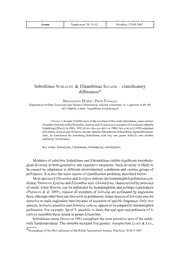
Sobraliinae Schlecht. & Elleanthinae Szlach. – classificatory differences PDF
Preview Sobraliinae Schlecht. & Elleanthinae Szlach. – classificatory differences
Genus Supplement 14: 51-52 Wrocław, 15 XII 2007 Sobraliinae Schlecht. & Elleanthinae Szlach. – classificatory differences* Magdalena dudek1, Piotr tukałło Department of Plant Taxonomy and Nature Conservation, Gdańsk University, Al. Legionów 9, PL-80- 441 Gdańsk, e-mail: [email protected] abStract. In spite of differences in the structure of the seeds and pollinia, some authors classified Sobralia with Elleanthus, Epilyna and Sertifera as a members of a common subtribe Sobraliinae (dreSSler 1981, 1993; burnS-balogh & Funk 1986). Szlachetko (1995) separated Elleanthus, Epilyna and Sertifera into the subtribe Elleanthinae (Elleantheae, Epidendroideae). Also, he transferred the remaining Sobraliinae with only one genus Sobralia into another subfamily Vanilloideae. Key words: Sobraliinae, Elleanthinae, Orchidaceae, classification. Members of subtribes Sobraliinae and Elleanthinae exhibit significant morpholo- gical diversity in both generative and vegetative structures. Such diversity is likely to be caused by adaptation to different environmental conditions and various groups of pollinators. It is also the main reason of classification problems described below. Most species of Elleanthus and Sertifera indicate the hummingbird-pollination syn- drome. However, Epilyna and Elleanthus sect. Chloidelyna, characterized by presence of small, white flowers, can be pollinated by hummingbirds and perhaps Lepidoptera (Pridgeon & al. 2005). Almost all members of Sobralia are pollinated by euglossine bees, although other bees can also serre as pollinators. Some species of Sobralia may be atractive to male euglossine bees because of secretion of specific fragrance. Only two species, Sobralia amabilis and Sobralia callosa, appear to be adapted to hummingbird pollination. For example, lip of S. amabilis is short, flat and open and pollinaria of S. callosa resemble those found in genus Elleanthus. Sobraliinae sensu dreSSler 1981 comprised the most primitive taxa of the subfa- mily Epidendroideae. The subtribe included five genera: Arpophyllum llave & lex., *Proceedings of the 8th Conference of the Polish Taxonomical Society, Wiechlice 18-20 V 2007 52 MAGDALENA DUDEK, PIOTr TUKAłłO Sertifera lindl. & rchb. f., Sobralia lindl., Xeorchis Schlecht. and Elleanthus PreSl. dreSSler, followed by burnS-balogh & Funk in 1986, classified Sobraliinae with the tribe Arethuseae. In 1993, dreSSler discarded his previous concept and transferred So- braliinae to New World Epidendreae. Finally, Szlachetko (1995), basing on differences in the structure of the seeds and pollinia, separated Sobralia from remaining Sobraliinae sensu dreSSler 1993 and transferred them into the newly described tribe Elleantheae. Elleantheae, as delimited by Szlachetko, consists of three subtribes, Xerorchidinae and Arpophyllinae, both monotypic, and Elleanthinae with, three genera, Elleanthus, Sertifera and Epilyna. All three genera are characterized by similar morphology of the vegetative and floral parts, including gynostemium. The remaining Sobraliinae, with only one genus Sobralia, was then transffered into another subfamily Vanilloideae. In Sobralia, the pollen grains are loosely held together by elastoviscin and form a more or less S-curved soft mass, not found in Elleantheae. Almost all species of Sobralia have seeds of Bletia type. In contrast, members of Elleantheae are characterized by clavate to obovoid, almost equal in size pollinia with sticky caudicles on their apices. The seeds are of Elleanthus type, with only one exception in species of Xerorchis (Limodorum type). Within Sobralia only species, S. callosa L. O. WilliaMS have pollinia of Elleanthus type. This unusual state probably represent an interesting case of paralellism in plants pollinated by hummingbirds (Pridgeon & al. 2005). Another diagnostic feature, spongy tilosomes, is found in both Sobralia and Elleanthinae. However, this feature can’t be used exclusirely in verification of close relationships between these orchids, as this kind of tilosomes has also been noted in many Coelogyninae, and ocasionally in other groups of orchids as well (Pridgeon & al. 1983). The results of recent molecular studies concerning representatives of Elleanthinae and Sobraliinae indicate a close relation between Sobralia and Elleanthus (caMeron 1999, van den berg et al 2000, chaSe 2001, Pridgeon et al 2005). Unfortunately, in each phylogenetic analysis both subtribes were very poorly sampled, e.g. including some undetermined species of Elleanthus, single accesions of E. caravata (aulb.) rchb.f., and very few species of Sobraliinae sensu dreSSler 1993. Thus, both subtribes alone still require comprehensive phylogenetic studies, mainly based on DNA markers, which will help clarify the relationships within and between them and provide valuable information about orchid evolution. rEFErENCES burnS-baloh, P., Funk, V. A., 1986. A phylogenetic analysis of the Orchidaceae. Smiths. Contr. Bot., 61: 1-79. caMeron, K. M., chaSe, M. W., Whitten, W. M., koreS, P. J., Jarrell, D. C., albert, V. A., YukaWa, T., hillS, H. G., goldMan, D. H., 1999. A phylogenetic analysis of the Orchidaceae: evidence from rbcL nucleotide sequences. Amer. J. Bot., 86 (2): 208-224. dreSSler, r. L., 1981. The orchids, natural history and classification. 332 ss. Harvard University Press, Cambridge. —, 1993. Phylogeny and classification of the orchid family. 312 ss. Dioscorides Press, Portland. Pridgeon, A. M., Stern, W. L., benzing, D. H., 1983. Tilosomes in roots of Orchidaceae: morphology and systematic. Amer. J. Bot., 70(9): 1365-1377. Szlachetko, D. L., 1995. Systema Orchidalium. - Fragm. Flor. Geobot, Supl., 3: 1-137. van den berg, C., higginS, W. E., dreSSler, r. L., Whitten, W. M., Soto arenaS, M. A., culhaM, A., chaSe, M. W., 2000. A phylogenetic analysis of Laeliinae (Orchidaceae) based on sequence data from internal transcribed spacers (ITS) of nuclear ribosomal DNA. Lindleyana, 15: 96-114.
